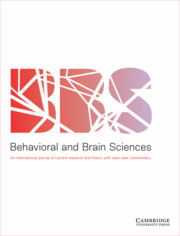Crossref Citations
This article has been cited by the following publications. This list is generated based on data provided by Crossref.
Liversedge, Simon P.
Drieghe, Denis
Li, Xin
Yan, Guoli
Bai, Xuejun
and
Hyönä, Jukka
2016.
Universality in eye movements and reading: A trilingual investigation.
Cognition,
Vol. 147,
Issue. ,
p.
1.
Xu, Yi
Wong, Roslyn
He, Shuhan
Veldre, Aaron
and
Andrews, Sally
2020.
Is it smart to read on your phone? The impact of reading format and culture on the continued influence of misinformation.
Memory & Cognition,
Vol. 48,
Issue. 7,
p.
1112.


Target article
Towards a universal model of reading
Related commentaries (33)
Thru but not wisht: Language, writing, and universal reading theory
An even more universal model of reading: Various effects of orthography on dyslexias
Are there universals of reading? We don't believe so
Beyond isolated word recognition
Beyond one-way streets: The interaction of phonology, morphology, and culture with orthography
Bringing development into a universal model of reading
Can evolution provide perfectly optimal solutions for a universal model of reading?
Consideration of the linguistic characteristics of letters makes the universal model of reading more universal
Developing a universal model of reading necessitates cracking the orthographic code
Does a focus on universals represent a new trend in word recognition?
Explaining word recognition, reading, the universe, and beyond: A modest proposal
Flashing out or fleshing out? A developmental perspective on a universal model of reading
Flexible letter-position coding is unlikely to hold for morphologically rich languages
Frost and fogs, or sunny skies? Orthography, reading, and misplaced optimalism
Giving theories of reading a sporting chance
No reason to expect “reading universals”
Orthographic consistency and parafoveal preview benefit: A resource-sharing account of language differences in processing of phonological and semantic codes
Orthographic processing is universal; it's what you do with it that's different
Perceptual uncertainty is a property of the cognitive system
Phono-morpho-orthographic construal: The view from spelling
Position-invariant letter identification is a key component of any universal model of reading
Rethinking phonological theories of reading
The case of the neglected alphasyllabary: Orthographic processing in Devanagari
The limitations of the reverse-engineering approach to cognitive modeling
The study of orthographic processing has broadened research in visual word recognition
Theories of reading should predict reading speed
Towards a universal neurobiological architecture for learning to read
Universals of reading: Developmental evidence for linguistic plausibility
Vision, development, and bilingualism are fundamental in the quest for a universal model of visual word recognition and reading
Visual perceptual limitations on letter position uncertainty in reading
Visual word recognition models should also be constrained by knowledge about the visual system
What and where is the word?
Writing systems: Not optimal, but good enough
Author response
A universal approach to modeling visual word recognition and reading: Not only possible, but also inevitable